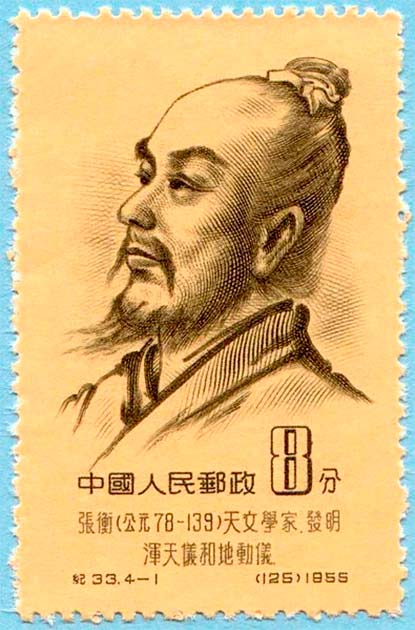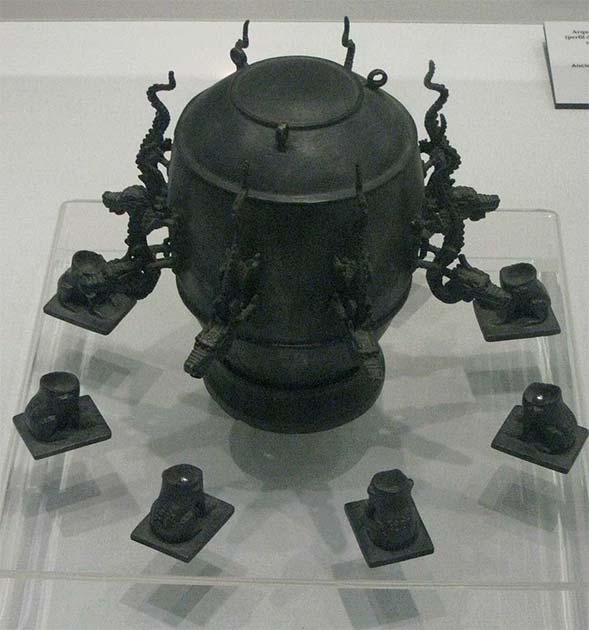The term “Renaissance man” hails from fifteenth-century Italy and defines a person with skill and knowledge in many different areas. One of the most notable examples of such brilliance was Leonardo da Vinci.
More than an artist, da Vinci was an architect, engineer, scientist, and keen inventor. You can thank da Vinci for the parachute, early helicopter, and flying machine, but his popularity betrays a western view of the development of civilization.
Zhang Heng is best described as another Leonardo da Vinci, only he lived 1,400 years earlier and in China. One of his many inventions was a device that could detect the direction an earthquake had occurred, even if it was hundreds of miles or kilometers away. What made Zhang Heng’s seismic toad urn so unique and so mysterious?
Zhang Heng’s Great Invention
Zhang Heng was a brilliant man who lived during the Han dynasty in China from 78 AD to 139 AD. He was educated in the capital cities of Chang’an and Luoyang and is remembered for his success in mathematics, astronomy, ethnography, engineering, inventing, and politics.

Some of Zhang Heng’s many accomplishments included providing a more accurate calculator for pi, at 3.154, the world’s first water-powered armillary sphere that was utilized in the study of astronomy, and the world’s first seismoscope. A seismoscope is a device that will indicate the shaking of the ground during an earthquake.
The unique seismoscope that Zhang Heng created almost 2,000 years ago was incredible, not least because it was built before humanity knew what tectonic plates were and how they caused the earthquakes the device was an alert for.
- Archimedes’s Weapons of War: Embellished Stories or Deadly Devices?
- The Hewitt-Sperry Automatic Airplane: The First Cruise Missile?
Zhang Heng himself didn’t understand why earthquakes happened, believing them to be caused by air and wind. In his writings, Heng explained his beliefs about the actual cause of earthquakes. He wrote:
“The chief cause of earthquake is air, an element naturally swift and shifting from place to place. As long as it is not stirred, but lurks in a vacant space, it reposes innocently, giving no trouble to objects around it. But any cause coming upon it from without rouses it, or compresses it, and drives it into a narrow space… and when opportunity of escape is cut off, then ‘With deep murmur of the Mountain it roars around the barriers’, which after long battering it dislodges and tosses on high, growing more fierce the stronger the obstacle with which it has contended.”
Zhang Heng introduced the imperial court of China to his device (known as Houfeng Didong Yi) in 132 AD and proclaimed that the urn could detect the exact cardinal direction a distant earthquake came from. Unfortunately, the seismoscope was lost to time, and no illustrations were made to demonstrate the device’s inner and outer workings.
Still, from historical descriptions, we have an idea of what his invention looked like. Zhang Heng’s seismoscope looked like a bronze urn with eight dragon heads protruding from the device’s body. These eight dragons each held a small metal ball in their mouths, and when dropped, the balls would fall into the open mouth of a bronze toad positioned under each dragon’s head.
While it sounds like a really unique sculpture, the dragons’ heads were not for decorative reasons only. Each head was pointed in a cardinal direction, north, south, southwest, west, etc.
How The Seismoscope Worked
While the mechanics inside Zhang Heng’s seismoscope are unknown, it is believed that inside the urn was some sort of pendulum mechanism. When an earthquake occurred, the sensitivity of the pendulum to this movement would cause it to begin to swing even if it were too far away or weak to be felt by the people around it.
The pendulum would cause one of the dragon heads to release the ball into its mouth into the frog’s mouth to alert people that an earthquake had occurred, or was occurring. Someone would be able to look at the device and, based on which toad had the ball in its mouth, know in which direction to send aid.
There is one account that mentions that one day the seismoscope had worked and indicated that there had been an earthquake to the northwest of the capital. Since nobody felt the quake, the emperor and his aides assumed the device was a failure.
- The Secret of Greek Fire: A Dark Age Flamethrower?
- Silk: China’s Secret Material, and how that Secret Got Out
According to the story, a messenger brought news to the emperor several days after the dragon head dropped its ball that an earthquake had occurred about 248 miles (400km) to 310 miles (500km) northwest of the palace’s location. The Houfeng Didong Yi had been proven a success.
There have been several attempts to recreate Zhang Heng’s seismoscope throughout the 19th and 20th centuries. However, each iteration was unable to achieve the same level of accuracy that historical records describe.

In 2005 a group of archeologists and seismologists from the Chinese Academy of Sciences made an announcement that they had successfully created a functioning replica. The team made some alterations that differed from the original descriptions of Zhang Heng’s seismoscope.
Instead of eight balls, the team used a single ball balanced atop a small pedestal in the center of the urn. A pendulum was suspended above the ball, that lightly touched it. When the pendulum swung, it pushed the ball off its pedestal, into one of the eight channels, and out from a dragon’s mouth.
Only one ball was used so the instrument would not drop another ball if the pendulum moved, giving a “false reading”. Some historians believe that the reason it is so challenging to replicate Zhang Heng’s seismoscope is because it never existed. If this device existed, worked, and was like historical records say it was, it will always remain a mystery.
Earthquake Detection Today
In truth we no longer use seismoscopes at all to identify or locate earthquakes today. We use more sensitive and digitally advanced tools like seismometers or seismographs. We may see more advanced seismic tools in the coming future.
In 2016 and 2017, researchers determined earthquakes can be detected using submarine telecommunication cables “by measuring the fluctuations in the phase of the transmitted light pulses induced by the seismic event. In contrast to seismometers that are located at a single point in space and thus measure only one set of seismic waves, optical fibers are subjected to seismic disturbances over their entire length, which allows researchers to extract valuable information about the earthquake that might not be possible with a seismometer.”
The cost of installing seismometers along the ocean floor is astronomical, and the task is arduous. But with thousands of miles of submarine telecommunication cables already in place, they can carry seismic information around the globe just as quickly as they carry voice information.
Top Image: Zhang Heng’s device, where a dragon would drop a ball into a toad’s mouth to indicate an earthquake. Source: Unknown Artist / Public Domain.